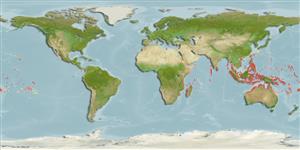Common names from other countries
>
Beloniformes (Needle fishes) >
Zenarchopteridae (Internally fertilized halfbeaks)
Etymology: Zenarchopterus: Particle zen, derived from zao = to give life + Greek, archos = anus + Greek, pteron = fin.
More on author: Valenciennes.
Environment: milieu / climate zone / depth range / distribution range
Ecologia
marinhas; Água doce; estuarina associadas(os) a recifes; pH range: 7.0 - 8.0; dH range: 10 - ?; oceanódromo (Ref. 51243); intervalo de profundidade 0 - 3 m (Ref. 86942). Tropical; 24°C - 28°C (Ref. 12468)
Indo-Pacific: Kenya, Mozambique, Seychelles, Madagascar, New Guinea, Solomon Islands, Australia, New Caledonia, Fiji, and Samoa. Reported from Sri Lanka (Ref. 6028) and Vanuatu (Ref. 13300). Also found in India, Malaysia, Thailand and Singapore (Ref. 43081).
Tamanho / Peso / Idade
Maturity: Lm ? range ? - ? cm
Max length : 19.0 cm TL macho/indeterminado; (Ref. 7050)
Descrição suscinta
Chaves de identificação | Morfologia | Morfometria
Espinhos dorsais (total) : 0; Raios dorsais (total) : 11 - 12; Espinhos anais: 0; Raios anais : 12 - 13; Vértebras: 42 - 43. Upper jaw distinctly wider than long. Snout uniform brown without any dark band on the midline. Pectoral fin shorter than head length. Lower jaw much shorter than head. Sixth and seventh anal rays of adult males greatly thickened and elongated, both rays reaching beyond the caudal base. Either dorsal ray 4 or 5 or both elongated and thickened.
Inhabit shallow water around mangrove in sheltered bays (Ref. 26367). Early juveniles are neustonic and float on the surface of estuarine mangroves (Ref. 43081).
Ciclo de vida ou comportamento de acasalamento
Maturities | Reprodução | Spawnings | Egg(s) | Fecundities | Larvas
Collette, B.B., 1986. Hemiramphidae. p. 163-164. In J. Daget, J.P. Gosse and D.F.E. Thys van den Audenaerde (eds.) Check-list of the freshwater fishes of Africa (CLOFFA). ISNB, Brussels; MRAC, Tervuren; and ORSTOM, Paris. Vol. 2. (Ref. 6798)
Status na Lista Vermelha da UICN (Ref. 130435)
CITES (Ref. 128078)
Not Evaluated
Ameaça para os humanos
Harmless
Uso pelos humanos
Pescarias: espécies comerciais
Ferramentas
Relatórios especiais
Baixar XML
Fontes da internet
Estimates based on models
Preferred temperature (Ref.
115969): 26.2 - 29.3, mean 28.6 (based on 2318 cells).
Índice de diversidade filogenética (Ref.
82804): PD
50 = 0.5000 [Uniqueness, from 0.5 = low to 2.0 = high].
Bayesian length-weight: a=0.00457 (0.00200 - 0.01044), b=3.03 (2.83 - 3.23), in cm Total Length, based on LWR estimates for this (Sub)family-body shape (Ref.
93245).
Nível Trófico (Ref.
69278): 2.9 ±0.5 se; based on size and trophs of closest relatives
Fishing Vulnerability (Ref.
59153): Low vulnerability (10 of 100).
